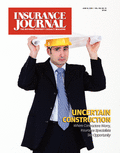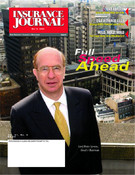A year ago, Lloyd’s course was “steady as she goes,” following the enormous losses of Sept. 11, but with the appointment of a new chairman last November, Lord Peter Levene of Portsoken, coupled with a surge in profits—£834 million ($1.31 billion) on an annualized basis—the new course appears to be “full speed ahead.”
That’s nothing new for Levene, 60, who’s very comfortable at the helm. Schooled in the tradition of the British Civil Service, his background includes experience in both the public and private sectors. He served as head of defense procurement under the Conservative government of Margaret Thatcher, and headed the huge and, until he took over, troubled Docklands rail link and the Canary Wharf development projects. He was an innovative Lord Mayor of London in 1998-99, and held a senior management position at Deutsche Bank before moving to Lloyd’s.
The only thing he seems to have missed is experience in the insurance industry. He’s the first “non-Lloyd’s member” to serve as the market’s chairman in its 315-year history. While his selection may have ruffled some feathers, it also sent a very clear message to the rest of the world—Lloyd’s is serious about fundamentally reforming the market; it’s not just window dressing. Choosing Levene as its head signals that the changes—adopting a franchise regime, going to annual accounting, modernizing all aspects of the way Lloyd’s does business—are real and permanent. He’s there to implement them and others, as needed. His presence has generated a palpable enthusiasm at Lloyd’s as it looks to the future.
The Council of Lloyd’s and the newly-created Franchise Board are responsible for the market’s organization and operation. Executive responsibility is in the capable hands of former management consultant Nick Prettejohn, who’s been at Lloyd’s since 1995 and has been CEO since 1999. Levene’s job, as described by Wendy Baker, the president of Lloyd’s America, is that of a “working Board chairman.” He’s responsible for making sure everyone works together to carry out policy, and he fills the crucial role of “representing Lloyd’s to the rest of the world.” Baker stressed that Lloyd’s is “the best insurance brand name in the world,” and a large part of the chairman’s job is to “bring that name to people’s minds.” Levene is adept at both roles, and he doesn’t mince words.
Levene tells it like it is
Last March he bluntly told senior industry executives at an Insurance Institute Conference in London to stop “shuffling mounds of paper,” if they wanted the industry to survive. “I have never come across an industry as paper-bound as the London insurance market, and I have to say that it even surpasses the civil service—where I spent some years—in the volume of its paper,” Levene said. “It’s odd to think that the fundamentals of the insurance industry have changed so little since the days of Edward Lloyd’s coffee shop. As an industry we have taken many steps forward but we need to go further if we are to maintain our position as the global market’s premier trading centre in the 21st century.”
The chairman went on to detail where the changes are needed, and how they’re going to be accomplished. His vision of the future includes making claims processing simpler and faster, and making sure there is “a greater degree of contractual certainty when policies are agreed.” It frequently takes more than 100 days to “turn a pencil-marked slip, agreed by a broker and an underwriter at Lloyd’s, into something recognisable to the customer as a policy document,” he noted. Technology could change all that.
Three key initiatives are currently underway to streamline the market:
• The London Market Principals, or LMP, – a program aimed at transforming, simplifying and speeding-up market procedures and changing behavior patterns;
• Xchanging – a “joined-up service provider” that is re-engineering policy production and claims accounting, i.e. making back office processing simpler, more efficient and faster; and
• Project Blue Mountain (recently renamed Kinnect) – described as “a new IT product that will enable brokers and underwriters to communicate to a degree never previously possible.”
Blasting the U.S. tort system
Nor has Levene taken a low profile on the international scene either. In a speech to the Chicago business community, held in conjunction with the recent RIMS conference, his target was the U.S. legal jungle. “The U.S. litigation system, if left unchecked, will destroy the American spirit of enterprise and drain the U.S. economy,” he frankly told his listeners. While Americans might expect that from AIG CEO Maurice “Hank” Greenberg, who earlier told RIMS delegates that his company would launch an ad campaign ranking states by how their legal systems treat business, coming from a British Lord it had to be a shock. Speaking at the Union League Club, Levene called for reforming the law to stop a culture in which businesses are more prepared to cease trading than face the risk of litigation, and individuals are living in fear of being sued.
Lloyd’s has a vested interest in controlling the spiraling costs of litigation, as the U.S. is the largest international market for Lloyd’s underwriters, accounting for over a third of its premium income. “Between 38 and 40 percent of our business comes from the U.S.,” Baker said, “around $8.2 billion—$3.2 billion from reinsurance and $5 billion from surplus lines and other sectors, and we’d like to do more business in the U.S.”
So when Levene pointed out that “the cost of the U.S. tort system has increased one hundred fold over the last 50 years and at current levels, tort costs are equivalent to a 5 percent tax on wages,” it wasn’t an idle observation. He then cited the estimates made in a recent study by Tillinghast-Towers Perrin that litigation outlays would reach $298 billion by 2005, and urged Congress to act against the awarding of excessive damages.
Deftly mixing his metaphors Levene warned, “The U.S. system of civil litigation has spawned an American pastime, something that ranks alongside catching a game of baseball or basketball: going to court to sue other people, or companies, or organizations, or the Government. And as more and more people have gone to court, not only has the cost of doing so risen, but so too has the cost of insuring oneself or one’s company against litigation.” Then he added, “to a foreigner like me, the drain that this system has on the U.S. economy is unbelievable,” and concluded: “In the dark days of the Depression, Franklin D. Roosevelt memorably told Americans that ‘the only thing we have to fear is fear itself.’ We cannot allow ourselves to create a culture in which you have everything to fear, unless you are covered by insurance and have a good attorney.”
Lloyd’s is not a ‘reinsurance alien’
Following his “daisy cutter” bombardment of the legal system, Levene launched a guided-missile strike on U.S. regulators, calling the current system inherently unfair, and urging the U.S. “to accept Lloyd’s as a loyal partner rather than reinsurance aliens.” Speaking to the National Press Club, he zeroed in on the rules for funding reinsurance liabilities. As a non-U.S. or “alien reinsurer,” Lloyd’s is required to hold collateral in the U.S., either by way of expensive letters of credit or cash, in non-working trust funds, amounting to 100 percent of its gross liabilities.
Although he didn’t specifically discuss it, the Sept. 11 attacks exacerbated the problem. Lloyd’s had £4.1 billion ($6.44 billion) in its U.S. reinsurance trust fund at the end of Sept. 2001. Within weeks it had to substantially increase that amount, which precipitated several cash calls as Lloyd’s scrambled to raise an initial £780 million ($1.225 billion). It eventually transferred $5 billion to the reinsurance fund. “Currently, we have around $9 billion dollars tied up in funds in the U.S.,” Levene continued, and “we are required to deposit cash regardless of the amount or quality of reinsurance protection we have bought from other companies. This represents massive and needless overfunding of our liabilities. This funding burden cannot be sustained without a cost. Ultimately that cost is passed on in the price insurance companies are charged for reinsurance cover. Insurance companies in turn must charge policyholders, so the price of these requirements are often borne by the ordinary policyholder.”
The funding issue has also indirectly sparked a dispute between Lloyd’s and the insurers of its Central Fund, who initially paid part of the losses, as the syndicates reached their maximum levels. The companies now say that they aren’t responsible for those claims under the terms of the policy.
Levene focused on the Iraq War to bring his point home. “As we now see on our TV screens 24 hours a day, there is an unbreakable bond which links the United States and the United Kingdom. Despite our integral role in this market throughout the past 150 years, Lloyd’s is treated as an alien insurer and reinsurer. Is this really how we deserved to be treated? Wouldn’t equal treatment improve the process for all parties?”
He also pointed out that the U.K. regulates Lloyd’s in the same way insurance departments regulate U.S. insurers, and insisted that there was no necessity for the onerous trust fund requirement. He called for a change in the law to allow market forces to operate freely, which would permit insurance to be priced more competitively and economically.
Welcoming profitability
Levene’s hand has been strengthened by Lloyd’s recently announced projected 2002 profit of £834 million ($1.31 billion) on an annualized basis. While most of the industry was reporting drastically reduced profits and in many cases outright losses, Lloyd’s success appeared even more remarkable. On the old three year accounting system, which it’s in the process of abandoning, the results were even more impressive—£1.484 billion ($2.33 billion). It’s the first profitable year since 1996, and follows a £3.1 billion ($4.867 billion) 2001 loss, heavily affected by Sept. 11.
“These figures compare very favourably when measured against the market’s peer group,” Prettejohn commented. “Lloyd’s combined ratio for 2002 was 98.6 percent. This compares with an average of 105.1 percent [source CSFB] for European reinsurers, 121.3 percent [source RAA] for US reinsurers and 108.3 percent [Source BI] for US property and casualty insurers.”
Lloyd’s accounting doesn’t include realized gains and losses from the investments of its syndicates, but the fall in equity values that began in 2000 and has been an important factor ever since, hasn’t really affected them. Andrew Moss, Lloyd’s director of Finance, explained in a conference call discussing the earnings that “only one percent [of investments] is in equities;” the rest is in cash or fixed income securities.
Lloyd’s strong performance in 2002 is reflected in the additional strength of its reserves. Net resources, the difference between its total assets of £49.296 billion ($77.4 billion) and total liabilities of £41.787 billion ($65.606 billion), rose 85 percent in 2002 to £7.509 billion ($11.789 billion), “a dramatic improvement in the capital position,” Moss observed.
The Central Fund, the ultimate link in Lloyd’s chain of security which was established to pay claims when the syndicates are unable to do so, also benefited from the strong gains, rising from £363 million ($570 million) in 2001 to £563 million ($884 million) last year. Its prospects for growth in 2003 have been clouded, however, by the current dispute between Lloyd’s and the six insurers with whom it concluded a reinsurance policy in 1999 covering exceptional fund losses.
Payments to the Central Fund
Lloyd’s identified the insuring companies and their participation as follows:
• SR International Business Insurance Company Ltd (a subsidiary of Swiss Re) – 32.5 percent;
• Employers Reinsurance Corp-oration – 20 percent;
• St Paul International Insurance Company Ltd – 20 percent;
• International Insurance Comp-any of Hannover Ltd (a subsidiary of Hannover Re) – 15 percent;
• XL Mid Ocean Reinsurance Ltd – 10 percent; and
• Federal Insurance Company (a subsidiary of Chubb) – 2.5 percent.
The dispute concerns payments made on the policy, which provides for a £350 million ($550 million) maximum payment in any one year and £500 million ($785) million over its five year life.
When cash calls, following the Sept. 11 attacks, exceeded £100 million ($157 million), it triggered the policy and Lloyd’s has received some £134 million ($210 million) in payments. The companies have, however, withheld any additional amounts. Swiss Re indicated it had told Lloyd’s that the companies would not pay certain claims, as they considered them outside the terms of the policy. “Lloyd’s has submitted claims for discretionary payments from the Central Guarantee Funds used to protect members solvency and to fund liquidity requirements, particularly in the United States,” Reuters News Agency quoted Swiss Re as stating. “This is not the purpose for which the insurance cover was intended and as such the reinsurers strongly dispute these claims.”
The difference is sizeable, £290 million ($455 million). Neither the companies nor Lloyd’s have given any further details about the claims, as they are currently in arbitration proceedings, but both Prettejohn and Moss stated that “Lloyd’s has a strong case.” A loss would reduce the Central Fund to £522 million ($820 million), but considering that it was originally funded with $56.5 million in 1998, that’s still a fair amount to have accumulated in five years. Even if Lloyd’s loses the case it is not expected to affect its activities.
A ‘lean and mean’ market
By happy circumstance Levene inherited the good results from the efforts of his predecessors, Sax Riley and Max Taylor, but he’s now in an even better position to build on their work. Americans would say Lloyd’s is now “leaner and meaner.” There are currently 71 syndicates operating at Lloyd’s, a considerable drop from the 139 in 1999 and 108 as recently as 2000.
The remaining syndicates are larger, more financially sound and can operate more efficiently. Corporate capital now accounts for 87 percent of Lloyd’s capacity, and this year it has more than it has ever had, £14.4 billion ($22.61 billion). “We intend to use every bit of it,” said international markets director Julian James at the earnings conference call. He pointed out that contrary to conditions in the 90s, when not all of Lloyd’s capacity was taken up, the hard market, and Lloyd’s strong fundamentals, have led to a surge in demand for coverage.
Kinnect – attacking the hidden costs of miscommunication
Having already started the LMP initiative to standardize and speed up market procedures and having attacked back office paperwork with the Xchanging agreement, Lloyd’s has now launched what may turn out to be its most far-reaching and important initiative yet. Kinnect, formerly called the Blue Mountain Project, aims at nothing less than making the entire London market, including Lloyd’s U.S. operations, perform with much greater efficiency than they presently do.
“We’re aiming to enable people to effect changes [in the way they conduct business] in order to help them become more efficient,” said Kinnect CEO Ashok Gupta. He explained that the project, while it certainly makes use of technology, is “much more than another database.” It targets problems inherent in covering large and complicated risks, which is Lloyd’s specialty. Gupta gave an example for airplane coverage. “Fifteen to 25 organizations may be involved—the insurers and the various underwriters that take portions of the risk, the reinsurers, the retail broker, the wholesale broker, etc. All these people need to share information.” However, as they usually employ different information systems, transferring the required data becomes a problem. You can Fedex it, or you can do it electronically, but in either case it has to be physically transferred, “re-keyed,” from one counterparty’s system to each of the other counterparties’ systems.
How big a problem is this? Gupta and his team have been working on Kinnect for two years. They conducted 150 interviews over a five-month period with insurers, reinsurers and brokers. “Fifty percent of the policies have errors,” Gupta said, “and 65 percent of those errors are ‘re-keying’ errors.” His conclusion: Of the some four million policies issued by the London market every year, 1.5 million of them have to be redone because of re-keying errors, i.e. errors in data transmission cause big problems. “The ‘frictional cost’ is enormous,” Gupta continued; “we want to eliminate the errors to provide better service, better risk analysis, and release people from the administrative drudgery.”
Kinnect is not a trading platform like inreon, or an administrative processing service like RI3K. Gupta likened it to a translating service, which accepts data from all the parties to a transaction, and then makes it available to the other parties. “Each user maintains his own system.” Brokers, underwriters and their customers will continue to meet face to face, but the interface provided by Kinnect will palliate the problem of re-keying data entries for each party. Eventually it could eliminate it entirely.
“Our goals are to reduce E&O liability, provide better information in order to price risk, [thereby providing] better use of capital, and [an accurate determination of] how much reinsurance you really need,” Gupta said.
Apparently international brokers Marsh and Willis and four major London-based insurers, ACE European Group, Amlin, Beazley and Wellington are already believers. They were the first companies to sign letters of intent to use the new service. “Today marks the beginning of the next phase of pre-roll out activity for Project Blue Mountain,” Gupta commented in a written statement. “Last year we designed and built the platform in conjunction with partners, including HP and CGI. Now we are preparing to roll out the brand and start implementation with a targeted group of users. We will work closely with these six companies to help them implement more efficient processes and to fine tune our own offering.”
The job will be complex. “We’re not giving it a lot of press or a high profile until we can deliver,” Gupta said. “People will need time to become comfortable with it.” He also acknowledged that, as with any complex system, it will take time and experience to work out all the details and eliminate problems.
Initially, Kinnect will concentrate on three main sectors: commercial property, E&O and D&O including facultative reinsurance. Plans call for expansion into other sectors, including treaty reinsurance, as the business builds up, expands, and as more companies become involved. While Kinnect is a private company, currently 100 percent owned by Lloyd’s, plans also call for widening the ownership in the future. “Lloyd’s is a ‘sponsor’ for the project,” Gupta said, “and we want to retain [the necessary] neutrality.”
Lloyd’s is in a unique position as far as projects like Kinnect are concerned. As the world’s biggest insurance market, doing business in practically every country, it recognized the need to improve communications between the people who do business there and was willing to invest time and money to find solutions. It now has a bonus in Levene, who not only understands these problems, but also is willing to do whatever it takes to solve them.
Commenting on the need for change in his address at the Insurance Institute, Levene said “For the first time in many decades there is light at the end of the tunnel. There are three initiatives that hold the key to the future of this market. These are London Market Principals, Xchanging and Project Blue Mountain. They apply 21st century thinking and technology to problems that have dogged us for decades and have the potential to make significant inroads into our timings.”
He warned, however, “in order for that full potential to be reached, the whole of the market must play its part. We can put forward technical solutions, but unless we are prepared to adopt them, to develop them, and to change our well-worn rituals in accordance with them, we will never deliver the degree of change that is now within our grasp.” It’s doubtful that Lloyd’s could have chosen a better man to lead the way than Lord Peter Levene.
Topics Lawsuits USA Carriers Profit Loss Agencies Claims Excess Surplus Reinsurance Market Lloyd's London
Was this article valuable?
Here are more articles you may enjoy.


 DeSantis Signs Law Giving Condo Owners Some Relief, But Questions Remain
DeSantis Signs Law Giving Condo Owners Some Relief, But Questions Remain  Erie Insurance Facing 2 Class Actions Claiming Data Breach
Erie Insurance Facing 2 Class Actions Claiming Data Breach  Homes With Toxic Smoke Damage Deepen Insurance Nightmare in LA
Homes With Toxic Smoke Damage Deepen Insurance Nightmare in LA  US E&S Growth Slowed Again in ’24; Berkshire, AIG Top Premium Rankings
US E&S Growth Slowed Again in ’24; Berkshire, AIG Top Premium Rankings 


